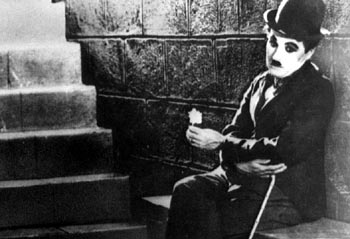Unwelcome Tramp
The town of Niles celebrates Charlie Chaplin this Saturday, but in 1914 they were glad to see him go
By Lauren Barack
'I BET YOU want to know about Chaplin," says Phil Holmes, 73, who has spent nearly 20 years in the town of Niles giving tours and learning stories from the old-timers. And in faded blue jeans and black workman boots, with stiff white hair and sunspots, Holmes looks the part of a Western tour guide.
For three months, comedian and silent-film star Charlie Chaplin lived in a small cottage in Niles, located in the city of Fremont, tucked up against the foothills between Union City and Mission San Jose. He shared his pad, according to the old-timers, with a San Francisco waitress Chaplin turned into a movie star. "I don't think they ever wrote about this in the newspapers," Holmes says, "but there was some gossip in town about it."
Edna Purviance would star in almost all of Chaplin's films, including the five he shot in Niles. The most famous, The Tramp, would forever burn the lonely shot of Chaplin into film history, his black bowler firmly on his head, his back to the camera, shuffling his way up a dusty road into Niles Canyon.
And the town, in turn, has made Chaplin its touchstone. His figure gazes out on the one-lane street from storefronts and bar windows. His smiling, mischievous face greets visitors who drive past the town's welcome sign.
"But Chaplin didn't like Niles," Holmes says slowly, "and the people didn't like him all that much either. He came in January, and by April he was gone. He didn't go to the Chamber of Commerce meetings. Didn't go to the school board meetings. Didn't walk in their parades. And now we have a Chaplin day. And everyone thinks he was the only movie star who lived here."
During baseball games, Chaplin would crawl under the bleachers and pinch the bottoms of young women. "He had a different kind of sense of humor. And it was a little too personal for the town," says David Kiehn, 48, who has spent the past three years working on book about Essanay studios, the film company that hired Chaplin to work in Niles. "Young women still needed chaperones. And Chaplin was just too risqué."
It was Christmas 1914 when Chaplin first came to Niles. The downtown, just as it is today, was little more than five blocks long. Hotels, restaurants and bars were the main businesses, supporting the railroad that began to stop in Niles in 1869. "It was the true last link in the transcontinental railroad," Holmes says, and as if on cue a morning Amtrak rolls by.
Chaplin had been hired by Essanay Films and its owners, George Spoor and his partner Gilbert "Bronco Billy" Anderson, "the world's first Western movie cowboy," Holmes adds. As Bronco Billy, Anderson starred in nearly 157 films, almost all shot in Niles. He hired Chaplin at a weekly rate of $1,250, "when other Essanay actors were making between $50 and $150 a week," Holmes says.
"But Chaplin took one look at Niles and left for Chicago," where Essanay had another studio. By January, Anderson had lured him back, but the two would never get along. "Anderson tried to tell him how to make a movie," Holmes says. "And Chaplin hated this. He wanted to do things his way. Sometimes he would spend three weeks making a movie, while Anderson could make one in three days. But Chaplin, he was an artist."
After he finished The Tramp, Chaplin moved back to Hollywood, where the company had built him a new studio. The one in Niles closed soon after, and by the 1930s it had been torn down.
Holmes starts to walk toward it but decides to drive the three blocks instead. He circles the street, pointing out the nine tiny bungalows still standing that housed Chaplin and other actors. He stops his car at a square plot choked with weeds--the site of the old studio. "There used to be horseshoe prints in the cement from the cowboys' horses, but they're gone," Holmes says. "And there was an old studio sign, but that's gone, too."
The town started holding a Chaplin day, or Essanay day, nearly 50 years ago. This year it's on June 6, with a dress-up contest, town tour and screenings of Chaplin and Bronco Billy films.
There is a new bronze plaque that tells a brief history of the studio, and the actors like Chaplin, Anderson and Ben Turpin who worked in Niles. "But it's halfway up the road," Holmes says. "And on the wrong side of the street."
From Highway 680, take the Mission Boulevard-Highway 238 exit. Travel west for four miles, and turn left at Niles Canyon Road.
[ San Jose | Metroactive Central | Archives ]
Copyright © Metro Publishing Inc. Maintained by Boulevards New Media.
![]()

How to get to Niles: From Highway 880, take the Niles-Alvarado exit, continue on Alvarado Road eight miles toward the foothills. Pass through Union City and on to Niles.
From the June 4-10, 1998 issue of Metro.
![[Metroactive Features]](http://metroactive.com/features/gifs/feat468.gif)